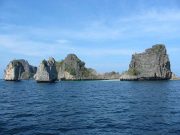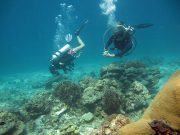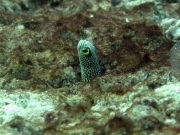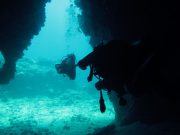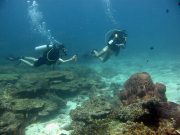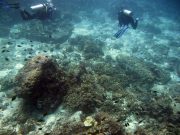Koh Haa Diving
Mu Ko Lanta National Park
Koh Haa, a cluster of six small islands located in the Andaman Sea, is one of the most spectacular dive destinations in Thailand, with crystal-clear waters, dramatic underwater landscapes, extensive coral reefs, and often excellent visibility.
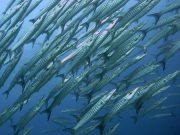


Situated roughly 20 kilometres west of Koh Lanta, Koh Haa is just a short speed boat ride from our office at Lanta Castaway Beach Resort. This diving paradise is accessible to divers of all skill levels, making it a popular destination for both novices and more experienced divers.
The dive sites at Koh Haa are also great for scuba courses and student divers, including introduction dives, check dives, and open water diver courses.
The name "Koh Haa" is short for the full name, “Koh Haa Yai”, which literally translates to "Five Islands and the Big One" in Thai, and each of these six islands offers unique diving experiences that cater to both novice and experienced divers.
Koh Haa Marine Life
A scuba diving paradise
The waters around Koh Haa are home to a rich array of marine life, making it a popular destination for underwater photographers and marine enthusiasts. The combination of nutrient-rich currents, diverse underwater habitats, and protection from overfishing ensures that Koh Haa remains a thriving ecosystem.


Find out more from the Thailand Department of National Parks on the Mu Koh Lanta Marine National Park.
Coral Reefs
Koh Haa boasts some of the healthiest coral reefs in the region, with a mix of hard and soft corals that create vibrant underwater landscapes. The reefs are teeming with life, including various species of staghorn corals, bubble corals, honeycomb corals, and mushroom corals. Colourful sea fans and sponges also adorn the reefs, providing shelter for countless marine species.
Fish Species
The diversity of fish species at Koh Haa is one of its main attractions. Divers can expect to see a wide range of reef fish, including surgeonfish, grouper, wrasse, angelfish, triggerfish, butterflyfish, parrotfish, stonefish, and damselfish.
Schools of moorish idols, snappers, batfish, fusiliers, and barracudas are common, while larger pelagic species such as trevallies and tuna occasionally pass by.
Whale Sharks @ Koh Haa
The largest known fish species, the Whale Shark (Rhincodon typus), is a slow-moving, filter-feeding carpet shark, and Koh Haa is a prime spot for encountering these ocean giants.
We do see whales sharks at Hin Daeng & Hin Muang occasionally, and even around the Bida islands sometimes, but we see more whale sharks around Koh Haa than anywhere else in this part of the Andaman Sea.
Macro Life
Koh Haa is a paradise for macro photographers, with a plethora of small, colourful marine creatures to discover.
Nudibranchs, flatworms, sea moths, and various species of shrimps and crabs can be found hiding among the corals.
The area is also known for sightings of seahorses, ghost pipefish, garden eels, and frogfish, which are a delight for keen-eyed divers.
Other Marine Life
Beyond the fish and macro life, Koh Haa's waters are home to various other marine creatures. Hawksbill turtles are frequently spotted grazing on the reefs, while octopuses and cuttlefish can be found camouflaging themselves among the rocks and corals.
Divers will also find sea cucumbers, giant clams, giant barrel sponges, christmas-tree worms, moray eels and reef squid on their dives at Koh Haa.
The occasional sighting of eagle rays, jenkins rays and guitar sharks add to the allure of diving at Koh Haa, making each dive an exciting and unpredictable experience.
Koh Haa Lagoon
The Lagoon at Koh Haa is one of the most iconic dive sites in the area. Enclosed by the surrounding islands, the lagoon offers calm, shallow waters with depths ranging from 5 to 15 metres.
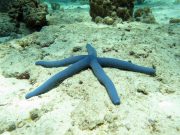

The sandy bottom is interspersed with coral bommies, which are home to a variety of reef fish and invertebrates. The clear waters and gentle conditions make this site ideal for beginner divers, snorkelers, and underwater photographers.
Koh Haa Lagoon: Island Two and Four
Mooring up in the Lagoon allows us the chance to dive both in and around the Lagoon, and also around the deeper east sides of both Koh Haa Two (also known as Japanese Island) and Koh Haa Four.
Diving Koh Haa Two & Four begins in the lagoon shallows around 5 - 8m, gradually dropping off into deeper water on the outer (south) edges of the islands.

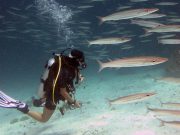
The reef slope outside of Koh Haa Four starts around 15 m, extending to 45m +. The slope comprises a large number of coral bommies and sandy rubble areas, teeming with schools of fusilier, snapper, and larger predators hunting on the reef, such as trevallies and barracuda.
The shallows of Japanese Island (Koh Haa Two), especially inside the Lagoon, have created a wonderful hard and soft coral garden, and a great number of species can be found between 3 m and 10 m.
The diversity of species between the islands here is fantastic, with the sandy/rubble area between Koh Haa Four and Japanese Island providing countless subjects for the macro photographer.
The Garden Eels
In addition to the macro life between Koh Haa Four and Japanese Island, there is a huge cement boat mooring block deeper, at 30m. Immediately beyond this mooring block is a huge field of garden eels.

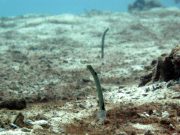
If approached carefully, the eels will remain out of their burrows, waving in the water column to catch food and oxygen.
As you would do with any deeper dive, please be aware of air consumption and no-stop dive times in the deeper areas of Koh Haa.
There are also two very old resident garden eels living on the shallower south side of Koh Haa Four. Say hello on your way past, but please try not to disturb them…
Koh Haa Lagoon: Behind Island Three
Behind the lagoon on the west side of Koh Haa Three, divers will find two excellent dive sites. Entering at the midpoint of Koh Haa Three, divers have the choice to head north into the Lagoon (right shoulder), or south into the Lagoon (left shoulder).


Both routes are very different, with the south route being more shallow, with softer slopes, and sandy/rubble bottom extending beyond 30 m. Here you can find batfish, harlequin shrimp, moray eels, snapper, and trumpetfish. As you turn into the lagoon you will find giant barrel sponges and huge malabar grouper patrolling the reef.
Heading north, divers will find a huge sloping whip coral garden, leading deeper to massive coral formations which are teeming with thousands of fish. Large schools of pelagics, including huge trevallies can be seen hunting the fusiliers and snapper bait balls which live around these bommies.
Koh Haa Lagoon: Snorkelling
The shallow lagoon is one of the best snorkelling sites in the Lanta Marine Park, home to thousands of healthy and robust corals, and hundreds of different marine life species.
This is also a fantastic place to see schools of bigeye barracuda, feeding parrotfish, wrasse, snapper, groupers, damselfishes, butterflyfishes, and sometimes hawksbill turtles and baby blacktip sharks in the shallows.
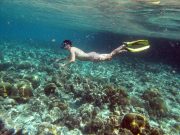
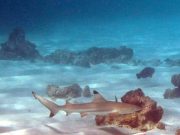
There is a small sandy beach at the heart of the lagoon where you can swim ashore for a rest, however due to the shallow corals, we can't bring our boats to the beach.
In addition to the coral lagoon, snorkelers can also easily explore the shallow reef areas around islands two and four.
Just under the surface, snorkelers can see crocodile needlefish, fusiliers, sergeant majors, and occasionally juvenile batfish from the school that lives on the outside of Koh Haa island Four.
Koh Haa Lagoon: Dive Site Guide
- NameKoh Haa Lagoon
- Visibility15m - 30m +
- Level of DivingAll Levels
- SnorkelingYes
- Depth1m - 45m +
- CurrentsMild to Medium
- Journey Time25 - 35 mins
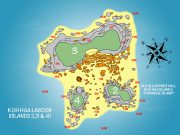
Book online to save 10% on dive trips and scuba courses on Koh Lanta.
Koh Haa Yai
The largest of the five islands, Koh Haa Yai is home to several very different dive sites, including the Cathedral, and probably has the largest amount of coral and marine life in this amazing archipelago.


The island is characterised by towering limestone cliffs that drop into the sea, creating dramatic underwater landscapes.
A shallow ridge connects Koh Haa Yai to Koh Daeng (Red Island), often called Koh Haa Lek or Koh Haa Six.
Koh Haa Yai: Caves North
To the south and west of Koh Haa Yai lies a shallow plateau, which makes a great starting point for several dive routes. We can normally moor up our speedboat in this sheltered area, and most dive shops on Lanta refer to this general area as “The Caves”.
Heading west and north from the plateau, divers will find a very steep rocky slope, covered in countless hard and soft corals. Visibility here is almost always excellent.
Schools of snapper, huge groupers, trumpetfish, cornetfish, pufferfish and moray eels are just some of the species you will find on this less-often dived northern route. Barracudas, golden trevally and bluefin tuna can often be seen hunting on the reef.
Koh Haa Yai: Caves South
Secondly, and more popular, divers can head to the east and south (left shoulder), as the plateau gives way to a wall dive, which in turn leads to several dramatic rock formations, just before arriving at the Caves.
A deeper plateau at 16 m sits in front of the caves, surrounded by a rocky ridge, and eventually sloping down to 30+ m. This wide coral reef is home to large areas of staghorn corals, soft corals, lettuce corals, and many other species.
Divers can spend time exploring the caves, The Cathedral, and the deeper reef in front of the caves, eventually making their way back round to the sheltered plateau at the start of the dive.
The Cathedral
There are three caves on the south west side of Koh Haa Yai, and approaching from the west, the first cave is smallish and only for the more comfortable/experienced diver. Torches are 100% necessary for the first cave.
The second cave is quite a bit larger, more like a cavern, and is connected to the third cave via a large 'window'. It is this third, cavernous cave which is famously known as 'The Cathedral' and is a 'must' for any suitably experienced diver when visiting the Koh Haa islands.
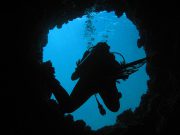

Inside the caverns, divers are treated to a mesmerising play of light filtering through the entrances, illuminating the interior and creating a cathedral-like ambiance.
Large schools of fish gather at the entrances to the Cathedral, and several types of nudibranch can be found around the soft corals on the entrance walls.
For those without any ear equalising problems, it's also possible to surface in The Cathedral where there is fresh air and some limited daylight shining through from the entrance. This peaceful cavern features dramatic stalactites and echoes of the waves surging into the Cathedral.
Cave to Beach
From the caves, divers can choose to continue east, where they will find a steep slope comprising huge rocks and wall formations, full of marine life.
This reef slope slowly becomes more shallow as it turns north and it approaches The Beach. The slope is covered in extensive coral formations, providing shelter for moray eels, and the large number of malabar and brown-marbled grouper found in this area.
Blacktip reef sharks, stingrays and giant grouper can sometimes be spotted in the deeper areas.
Just before reaching the beach area, divers will find a large shallow plateau at 5 m, completely covered in corals and sponges. Here you will find triggerfish, surgeonfish and butterflyfish and huge table corals.
Koh Haa Yai: The Beach
The rocky beach to the south east of Koh Haa Yai forms a small bay which is completely covered in dozens of species of hard and soft corals.
There are also several huge coral formations around the outer areas of the beach, home to millions of fish, shrimp, moray eels, and countless other species.
The shallows around the beach at Koh Haa Yai are also home to huge schools of sea chubs, and roving schools of parrotfish, scouring the reef for food in densely packed formations.
The sandy areas in the deeper parts are home to stingrays, sea cucumbers, surgeonfish, garden eels, damselfish, mantis shrimp, pipefish and many other species.
A long coral sloping reef runs to the north of the beach (left shoulder), with depths ranging from 2 m to 20m+, eventually connecting with the ridge to Koh Daeng.
Koh Daeng
Koh Daeng (Red Island) is the smallest island to the north of Koh Haa Yai, and is connected to Koh Haa Yai by a short coral/sandy ridge. Some people call this Koh Haa Six, or Koh Haa Lek, but the traditional Sea Gypsy name is Koh Daeng.
What looks like a small island on the surface actually spreads out underwater into an extensive reef area with walls, slopes and coral gardens surrounding the island.


In the shallows of Koh Daeng we can really see the red colour of the rock on this island. The shallows are also the perfect place to see schools of moorish idols feeding on the algae which covers these rocks in the shallows.
The reef around Koh Daeng mostly drops to 25 - 30 m, however the connecting ridge to Koh Haa Yai is more in the 12 - 15m range, with gentle slopes on either side.
On the outer (north) side of Koh Daeng, the smallest of the Koh Haa Islands, we may occasionally see larger rays, guitar sharks, or possibly a whale shark cruising past in the blue.
Diving from Koh Daeng to the rocky Beach area on the east side of Koh Haa Yai is a very nice dive, and makes an excellent drift dive in a dropping tide.
Koh Haa Yai: Dive Site Guide
- NameKoh Haa Yai & Koh Daeng
- Visibility15m - 30m +
- Level of DivingAll Levels
- SnorkelingYes
- Depth1m - 35m +
- CurrentsMild to Medium
- Journey Time25 - 35 mins

Book online to save 10% on dive trips and scuba courses on Koh Lanta.
Koh Haa One
The most northerly of the Koh Haa Yai islands is Koh Haa One (Koh Haa Neung in Thai), with a dramatic west side characterised by steep walls and huge rocks, and a more shallow east side, a mix of wall and sloping reef.
At the east side of Koh Haa One, a large rocky ridge runs from the edge of the island into the deeper water of the north east, creating a long coral encrusted finger visible from the surface, and teeming with life.
West Corner & North Wall
Most dives begin at the more sheltered southern side of Koh Haa One. From here, we can head to the west (right shoulder) past dramatic walls and gigantic rocks which are home to countless hard and soft corals, together with millions of fish.
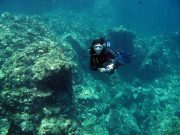

As we head along the wall to the west, we eventually arrive at the corner which turns north. This dramatic corner is sensitive to strong currents, which provide nutrients to the millions of soft corals clinging to the wall.
The top part of the wall is a shallow plateau, just a few metres deep, with the wall extending to well over 25 m at the corner. The deeper areas are home to a huge beautiful garden of purple and white carnation corals where we can sometimes spot stingrays.
The shear wall continues around to the north of the island, becoming more shallow in many areas, before eventually ending at the Finger on the east of the island.
There are several huge coral formations in the deeper areas to the north of Koh Haa One. These gigantic coral bommies are covered in hard and soft corals, with many large pelagic predators hunting the thousands of fusiliers and snapper which live around the bommies.
The Chimney & Fish Bowl
At the south west edge of Koh Haa One lies a series of swim throughs and caverns known as 'The Chimney', which is one of the highlights of diving the Koh Haa islands.
With several shallow entrances, a large, central chamber around 8 - 9m, an exit around 17m, and another shallow exit into the 'fish bowl' some parts of The Chimney can get a little narrow in places making it suitable for more experienced divers.


At the bottom of The Chimney lies a dense garden of white and lilac soft corals around 20 - 22m where the occasional turtle is found, along with stingrays, snapper, trumpet fish and many others.
Giant chunks of rock, fallen from the island above, lie in the sand to the south east of The Chimney - check the deep cracks in these boulders for huge snapper, grouper, and other species sheltering from the divers.
For the macro underwater photographer, countless nudibranchs, tiny crabs, shrimp, seahorses and ghost pipefish are just some of the many species to be found around the wonderful island of Koh Haa One.
Finger Reef
At the east side of Koh Haa One is The Finger. This is a rocky wall formation that seems to ‘grow’ from the main island, starting at just 2 metres, and 20m+ at its deepest point.
The north part of the wall is dark, dramatic, and subject to strong currents, whereas the south part gives way to a long sloping reef, with large areas of staghorn corals, leading to sandy ripple areas where we might see cobia, guitar sharks, black tip reef sharks and stingrays.
Koh Haa One: Snorkelling
The south side and eastern part Koh Haa One are best for snorkelling, especially around the shallow finger ridge to the east.
The south face of the island provides the best shelter from any possible winds from the north east, with plenty of coral and marine life to see in the shallow water right up to the sheer rock face of the island.
Koh Haa One: Dive Site Guide
- NameKoh Haa Neung (One)
- Visibility15m - 30m +
- Level of DivingAll Levels
- SnorkelingYes
- Depth1m - 35m +
- CurrentsMild to Medium
- Journey Time25 - 35 mins
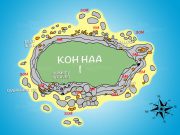
Book online to save 10% on dive trips and scuba courses on Koh Lanta.
Koh Haa Tides & Currents
Koh Haa Diving Conditions
When planning dives around the Koh Haa islands, is it worth remembering that a dropping tide will generally run from north east to south west, and a rising tide will generally run in the opposite direction, from south west to north east.
Some of the Koh Haa dive sites make excellent drift dives when currents are stronger a few days before, or after a full moon or a new moon.
It's also not unusual to have stronger currents running through the Lagoon, with careful dive planning necessary at certain times of the month.
Koh Haa Diving Price
Koh Lanta Dive Trips
Fun Diving price at Koh Haa is ฿3,150 for 2 dives. Diving price includes dive guide, free equipment rental, lunch & soft drinks on the boat when booked online in advance.
- 2 Dives
- FREE Equipment Rental
- Dive Guide
- Lunch & Soft Drinks
- 2 Dives
- FREE Equipment Rental
- Dive Guide
- Lunch & Soft Drinks
- You must be certified minimum SSI/PADI Open Water Diver, CMAS 1 Star Diver, BSAC Ocean Diver, or equivalent.
- Does not include Marine Park Diving Fee: Thai ฿240, Foreigner ฿600, per day.
See a complete list of all our Koh Lanta Diving Prices.
Book online to save 10% on dive trips and scuba courses on Koh Lanta.
Coral Reef Conservation
Protecting marine life at Koh Haa
Koh Haa is part of the Mu Ko Lanta National Park, a marine protected area. This status helps preserve the underwater ecosystem at Koh Haa, and ensures sustainable tourism practices.
Divers visiting Koh Haa are encouraged to follow guidelines that minimise their impact on the environment.
Responsible Diving Practices
To protect the delicate marine environment, divers are urged to follow responsible diving practices, including:
- Avoid touching or disturbing marine life while diving at Koh Haa: Many marine organisms are delicate and can be harmed by human contact.
- Practice good buoyancy control while diving at Koh Haa: Maintaining proper buoyancy helps prevent accidental damage to corals and other marine life.
- Do not collect souvenirs from Koh Haa: Removing shells, corals, or other marine life from the sea is illegal and harmful to the ecosystem.
- Dispose of waste properly: Do not throw any rubbish or food into the sea, especially at the dive site. Throwing food into the water at a coral reef interferes with the delicate marine eco-system.
- Use Reef Safe Sun Block: Ensure your sunscreen is Reef Safe and does not harm the corals and marine life at Koh Haa.
Koh Lanta Dive Sites
Some of Thailand's Best Diving
The Koh Haa Islands are some of the best dive sites in Thailand, and can be easily dived from Koh Lanta by speedboat along with many of Thailand's other top dive sites:
- Lanta Marine Park
- Koh Haa Islands
- Koh Rok Islands
- Hin Daeng & Hin Muang
- Hin Musang Wildlife Reserve
- Shark Point & Anemone Reef
- Phi Phi Marine Park
- Bida Nok & Bida Nai
- Hin Bida
- Koh Phi Phi
- HTMS Kledkaeo Wreck
- Hin Klai
Find out more at the Thai Department of National Parks.
Our Dive Trip Schedule
Lanta Dive trips from 15 Oct - 15 May
Our dive trips depart Koh Lanta in the morning every day during high season from the south end of Long Beach, normally returning around 1:30 - 2pm.
| Week Day | Boat 1 | Boat 2 |
| Monday | Koh Bida / Phi Phi | Koh Bida / Phi Phi |
| Tuesday | Koh Haa Islands | Hin Daeng & Hin Muang |
| Wednesday | Koh Bida / Phi Phi | Koh Bida / Phi Phi |
| Thursday | Koh Haa Islands | Koh Haa Islands |
| Friday | Koh Haa Islands | Hin Daeng & Hin Muang |
| Saturday | Koh Bida / Phi Phi | Koh Bida / Phi Phi |
| Sunday | Koh Haa Islands | Koh Haa Islands |
- All trips are 2 dives a day
- Trips depart from the beach at our dive shop @ Lanta Castaway Beach Resort
- Trips Depart 8/9am, return 2pm
- Dive & Relax is open from Oct 15 - May 15.
- E-mail us info@diveandrelax.com in advance with any questions, or to make a booking.
We may schedule a Shark Point & Anemone Reef dive trip or a KledKaeo Wreck & Hin Klai dive trip upon request. A minimum of 5 divers are required for these trips, please let us know if you are interested.
We love to dive as much as possible during the high season, however all our dive trips depend on the weather, sea conditions, currents and minimum numbers and may be subject to change at short notice.
Book online to save 10% on dive trips and scuba courses on Koh Lanta.
For more information on our weather and climate, check out the best time to visit Koh Lanta.

